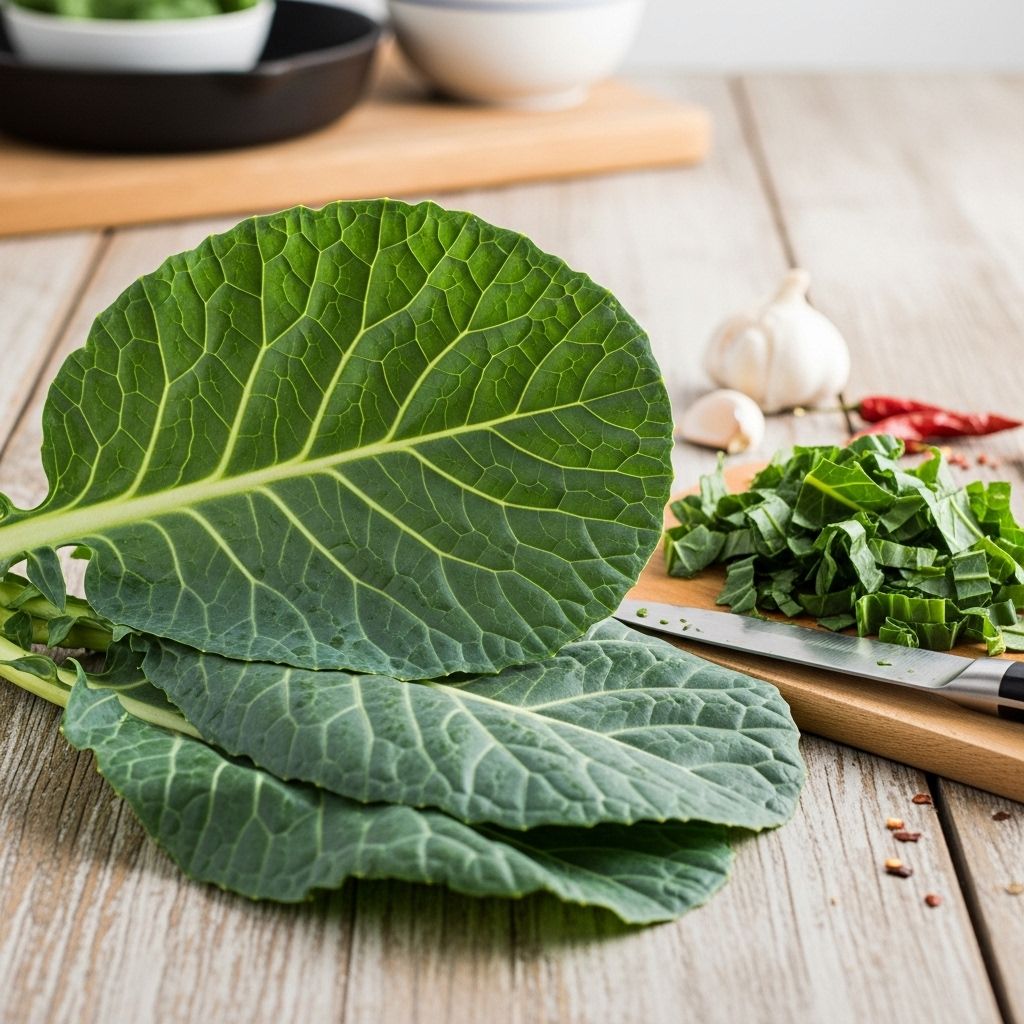Collard Greens: Unlocking Nutritional Benefits, Culinary Uses, and Taste
Discover the Power of Collard Greens for a Healthier You

What Is Collard Green?
Collard greens are a type of loose-leaf green vegetable, belonging to the cruciferous family, which also includes kale and broccoli. Unlike kale’s curly narrow leaves, collard greens have large, smooth, and flat leaves. Originating in the Mediterranean region, they are popular in Southern American cuisine and are known for their mild flavor, which is less bitter than kale.
Nutritional Value
Collard greens are exceptionally nutrient-dense while being low in calories. Here are some key nutrients and their quantities in a serving of 1 cup of raw collard greens:
- Calories: 11 – 12
- Carbohydrates: 2 grams
- Fiber: 1 to 1.4 grams
- Protein: 1 gram
- Fat: Less than 1 gram
- Vitamin K: High levels, crucial for blood clotting and bone health
- Calcium: Important for bone health
- Vitamin C: Essential for immunity and collagen synthesis
- Vitamin A: Supports eye health and immune function
- Folate: Crucial for cell growth and development
- Potassium: Helps regulate heart rhythms and blood pressure
Health Benefits
Collard greens are associated with several health benefits due to their rich nutrient profile and high antioxidant content. Some of these benefits include:
- Cancer Prevention: Cruciferous vegetables like collard greens have been linked to reduced risks of certain cancers, such as prostate, breast, and colon cancer.
- Bone Health: The combination of calcium and vitamin K in collard greens supports bone density and reduces the risk of osteoporosis.
- Eye Health: Rich in vitamin A, collard greens help prevent age-related macular degeneration and other eye disorders.
- Heart Health: High in fiber and potassium, collard greens can help lower cholesterol levels and improve heart health.
- Gut Health: The dietary fiber in collard greens aids digestion and supports healthy gut bacteria.
Uses and Recipes
Collard greens are versatile and can be used in various dishes, both raw and cooked. Here are some popular ways to enjoy them:
- Salads: Add raw collard greens to salads for a nutritious and flavorful twist.
- Smoothies: Blend with other greens and fruits for a healthy smoothie.
- Soups and Stews: Use collard greens to add nutrients and flavor to soups.
- Sautés and Stir-fries: Sauté with garlic and olive oil for a simple side dish.
- Wraps and Sandwiches: Use collard greens as wraps for sandwiches or as an addition to wraps.
Taste and Texture
Collard greens have a mild, slightly bitter taste, which is milder than kale. The texture is crunchy when raw and tender when cooked. They can be seasoned with herbs and spices to enhance their flavor.
Preparation Tips
Here are some tips for preparing collard greens:
- Remove Stems: Cut off the thick stems and tear the leaves into smaller pieces before cooking.
- Massage for Salads: Massage raw collard greens with olive oil and lemon juice to make them more palatable in salads.
- Cooking Methods: Sauté, steam, or boil collard greens with garlic and spices for a flavorful side dish.
FAQs
Q: Are Collard Greens Good for You?
A: Yes, collard greens are highly nutritious and packed with vitamins, minerals, and antioxidants that support overall health.
Q: How Do You Cook Collard Greens?
A: Collard greens can be cooked by sautéing, steaming, or boiling. Season with garlic, lemon juice, and spices for added flavor.
Q: Can You Eat Collard Greens Raw?
A: Yes, collard greens can be eaten raw. They are a great addition to salads and smoothies.
Q: What Are the Side Effects of Eating Too Much Collard Greens?
A: Consuming too much collard greens can lead to excessive fiber intake, causing bloating and gas. It is recommended to eat no more than a cup or two at a time.
Conclusion
Collard greens are a nutritious addition to any diet, offering numerous health benefits and versatile culinary uses. With their mild flavor and high nutritional value, they are an excellent choice for those looking to incorporate more greens into their meals.
References
- https://www.healthline.com/nutrition/collard-greens-benefits
- https://blog.lexmed.com/home/blog/2023/02/03/superfood-of-the-month-collard-greens
- https://www.webmd.com/diet/health-benefits-collard-greens
- https://www.strongrfastr.com/foods/collard-greens-11161
- https://www.urmc.rochester.edu/encyclopedia/content?contenttypeid=76&contentid=11162-1
- https://snaped.fns.usda.gov/resources/nutrition-education-materials/seasonal-produce-guide/collard-greens
- https://nutrition.umd.edu/label.aspx?RecNumAndPort=101042%2A3
- https://nutritionfacts.org/topics/collard-greens/
Read full bio of medha deb












